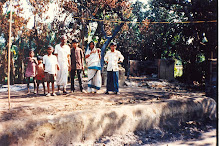 Indus Valley Approximate Sites
Indus Valley Approximate Sites
HARAPPA
–
Visit
to the Ancient city of Indus Civilization
Dr.
Sachi Ghosh Dastidar,
and
Dr.
Shefali Sengupta Dastidar
From
our college days we wanted to visit Harappa and MohenjoDaro, prehistoric cities
of Indian and Hindu civilizations and culture. Our first attempt to visit
MohenjoDaro in late 1980s failed because of civil disorders in Pakistan. Then
on a trip to Lahore in late 2000s, the cultural capital of Pakistani Punjab as
well as all of Pakistan, we decided to visit our heritage site. Our Lahore host
Professor Sindhu and her mother, whom we called Didi, older sister, found us a
nice air-con sedan for us to make the trip. We invited the mother and daughter
to join with us as they had never seen the place, leaving behind her other
grown children Shahid, Shabnam, Rizwan and Nabila for our day trip. Soon we
realized that not very many people in Lahore know about Harappa.
Harappa is a nice place
for a day trip from Lahore which is about 175 kilometers away (some literature
say it is 250 kilometers away,) and can be easily made in 3 hours. The journey
was quite pleasant as we passed villages after villages in that flat, green
farming countryside. There were no big signs to the site and the driver had to
ask locals for direction. Our first surprise came when the driver passed the
turn because of lack of signage. The road sign it was partly damaged and
written in mid-sized Urdu letters, not easily visible from a passing car. At
the ticket counter realizing entry fees to be 20 times higher for foreigners Didi
wanted us to pass for locals to save money. The official at the counter was
agreeable for Sachi to pass for a local with his Bengali “half-punjabi shirt,”
but he would have none of it with Shefali wearing pants. As we were traveling for
over 5,000 kilometers, mostly by road crossing many national boundaries, we
were carrying two small carry-ons. We had limited supply of local outfit with Shefali
carrying only one sari which she forgot to wear that day. “No Pakistani woman
wears pants,” was his answer. Harappa can be reached by train or bus from Lahore
via nearby Sahiwal town. One can easily have lunch, tea and dinner in roadside dhabas or eateries.
Walking down the brick
paths was exhilarating, exciting and hallucinating for us. It was “a dream come
true.” The entrance in English and Urdu introduction says, “MOUND ‘AB’ CENTRAL:
The high level of Mound is the result of continuous rebuilding of the city. In
this area the curved wall situated is actually what may have been a drain during
the final phase of Harappa occupation around 2200 and 1900 B.C. In the lower
levels there is a large well and a bathing platform that belongs to an earlier
period. This may have been public well associated with a bathing and washing area.
Unlike Mohenjodaro where there are discovered numerous wells in each neighborhood,
as yet only eight wells have been discovered in Harappa. Some of them were private
and some were public wells. Much of the top structures were robbed by the contractors
who built the Lahore, Multan railway track during British rule. The lower
structures were destroyed by the Harappan inhabitants to reconstruct their
houses. The archeological excavations were conducted here by Raj Bahadur Daya Ram
Shani and M. S. Vats during 1921 to 1924 A.D. and 1926 to 1934 A.D. (For more
details visit the Web site: www.harappa.com)”
As there were no other visitors, the security police doubled as a guide. This
was good for us, but sad for Pakistan, India and for students of Indus and
Indian Civilization. There was no rush of humanity – peasants and babus – as in
Sarnath and Kashi Viswanath in Varanasi, Kutub Minar in Delhi, Jaliiwanwala
Bagh in Amritsar, Victoria Memorial in Calcutta, Ajanta in Maharashtra, Konark
in Orissa, Bagan in Burma, or Gaya in Bihar. To us this solitude also felt even
more contrasting as we visited Xian in China a few days earlier on this trip.
In terracotta warrior-famed Xian, discovered only in 1970s, the China has built
a huge air-conditioned dome covering the entire site protecting it from the elements,
and in that process had made Xian the second-most visited place in China
bringing millions of tourists with billions of dollars of income and creating
tens of thousands of jobs. To protect the structures from further erosion in
Harappa many of them have been covered with plasters. The area is in further
jeopardy because of a water buffalo farm on its unguarded boundary and a Muslim
grave within the pre-historic city itself. Even at a leisurely pace the site
can be visited in an hour or two. Now it is several kilometers away from the river
on whose bank it was located.
There is a small museum
and a gift shop at its entrance run by the Archeological Department. A number
of booklets on the prehistoric city are available at the counter. All the
workers were eager to show us their collection. As we were almost at the end of
our long journey we bought one copy each of their collection because we won’t
have to hand carry for too long. (Space on our small boxes could be made only
by discarding some of our belongings.) As we were departing, the entire crew
said, “Come again, our Hindu friends.”
 Introduction of Harappa Site in Punjab, Pakistan
Introduction of Harappa Site in Punjab, Pakistan Ruins of Well
Ruins of Well







No comments:
Post a Comment